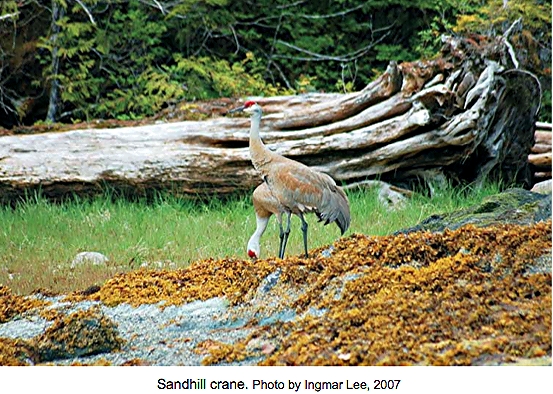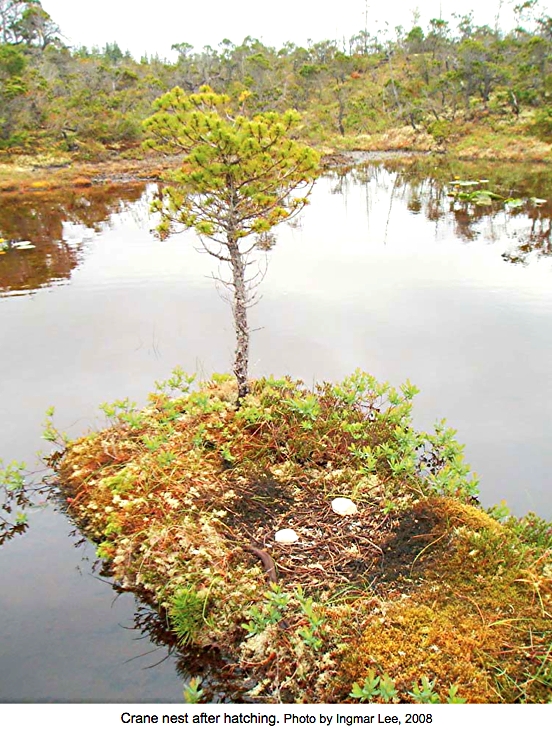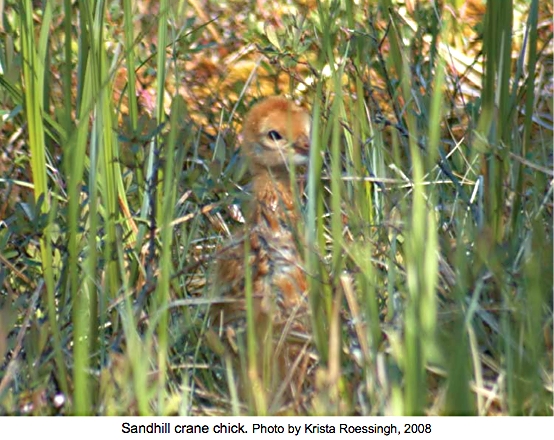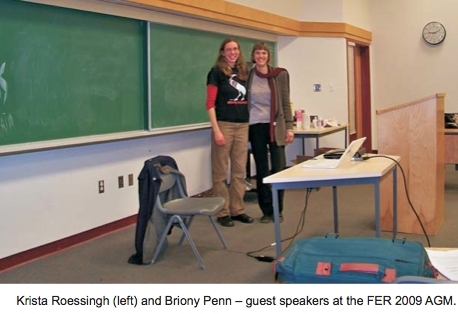
News/Reports
Sandhill Crane ER possibilities
There are many special areas of the province with sensitive ecosystems which need protection. Not all are well represented in our Parks / ER System so we encourage individuals to offer their proposals which we will carry and publicize on this website.
In the Ecological Reserve Newsletter, The Log , we have often carried articles on such areas. Below is one such area that we first heard about when Briony Penn invited Krista Roessingh to do a presentation at the Annual General Meeting in 2009. Perhaps someone from the North-Central B.C. coast with a passion for Sandhill Cranes may wish to take on this as a project:
From: THE LOG FRIENDS OF ECOLOGICAL RESERVES NEWSLETTER SPRING 2009
Sandhill Cranes of the North and Central B.C. Coast: Some Natural History
By Krista Roessingh
 Imagine paddling along a calm inlet with rocky beaches covered in golden rockweed, where lichen-shrouded hemlock, spruce, and cedar lean their boughs over the shore. The air is misty wet, the sky hung low with clouds, and the smell of cold, clean seawater drips from your paddle blades onto your clothes.
Imagine paddling along a calm inlet with rocky beaches covered in golden rockweed, where lichen-shrouded hemlock, spruce, and cedar lean their boughs over the shore. The air is misty wet, the sky hung low with clouds, and the smell of cold, clean seawater drips from your paddle blades onto your clothes.
Coming around a bend the shoreline opens up at a small estuary. There is a creek running out from the forest and over an ancient fish trap, with sedges and silverweed blanketing its banks. Some days you might see a wolf or a black bear and her cub here among the sedges.
Today on the far shore of the creek, two red and white heads pop up from the little meadow, already watching you. After a moment, one long grey neck goes down and pecks at something, and then the other, as they continue to warily feed in the rockweed.
Eventually the current carries you too close, and the large birds turn their grey bustles toward the forest edge and move stiffly up the beach. Above the high- tide line, they blend perfectly with greyed driftwood cedar logs and boulders while they wait and watch, occasionally nibbling a salal berry from the overhanging forest.
Suddenly, from somewhere beyond the forest you hear a primordial call. An echoing rattling bugle sound breaks the stillness of the scene and comes closer until you see a line of four sandhill cranes with necks outstretched, their wingtips arcing with graceful quick upbeats. They circle over the water and glide down to the beach with legs dangling, landing noisily on the other side of the creek from the pair of cranes, who respond with loud, perturbed calls.

These cranes are part of a small population that mainly breeds and summers in the archipelago of the Hecate Lowlands Ecosection, on the central and north coasts of British Columbia and on the southeast coast of Alaska. They occur in low densities, clustered in areas where there is a confluence of productive estuaries and sheltered beaches, upland bog with small pools, and old-growth forest in between. They are thought to belong to the rowani subspecies, which is intermediate in size between the lesser (canadensis) and greater (tabida) migratory sandhill cranes.
Based on recent telemetry studies conducted by Gary Ivey of the International Crane Foundation and others, many coastal breeding cranes stage in the Lower Columbia River area, and winter in the Central Valley of California with other cranes from the Pacific Flyway Population. Most cranes belonging to this larger population (approximately 25,000 cranes) actually use an interior route through northern B.C. on their way to their boreal and tundra breeding grounds. little knowledge of crane habitats in this area. The inner and outer islands of the central and north coast are mostly unroaded and uninhabited, accessible only by water or by air.
Biologist Ian McTaggart- Cowan and naturalist/collector Tom McCabe observed sandhill cranes on the outer islands of the central coast in 1928, and noted their unusual use of forest trails and bog nesting habitat.
From 2006-2008, we conducted helicopter surveys of high probability habitat, mainly on the central coast, in May, when cranes are nesting. These surveys were guided by local knowledge of crane locales gathered from mariners and naturalists.
In 2007 we followed up on aerial crane sightings by boat and on foot in order to identify more nest and roost sites, and in 2008 we conducted nest habitat and diet studies using a subset of these sites.
Over three field seasons, we located 29 nest sites on 14 different islands and one mainland peninsula, as well as several beach foraging areas and bog roost sites. In 2008, the average nest density was 0.044/km2, and the average crane density was 0.22/km2 for the nests and cranes located over an area of 430 km2. Nest and roost sites were found within 1.25 km of the shoreline, on the inner and outer islands between 51°50′ and 54°00’N where blanket mire complexes occur. It is very likely that crane nests occur further inland, but our survey transects generally covered a 1 km strip along the coastline because most of the sightings we knew of were made from the water.
The nests were typically in small (under 2.0 ha) pools in small basins dotted with mossy islets that provide perfect nest platforms, safe from flooding and terrestrial predators. Water in these nest pools was an average of 0.63 m (+/- 0.056 m) deep and mucky. The pools are formed by decomposing peat moss in ombotrophic peatlands, and are part of the coastal blanket mire complex. mosaic of bog woodland, open bog, drier forest and scrub forest site series. The vegetation around most nest sites is dominated by shore pine, red and yellow cedar, sweet gale, Labrador tea, coastal reindeer lichen, and Sphagnum mosses.
Most nests were not well concealed by vegetation; it seems more important for incubating cranes to be able to see approaching danger than to be hidden. However the average nest pool was within 100 m of forest cover over 10 m high, providing both isolation and cover for nesting cranes and their young.
The diet of 5 pairs of breeding cranes in the Bella Bella area (from fecal analysis) was composed mainly of perwinkles and small mussels foraged from the rockweed zone of the lower intertidal, sedges from the upper intertidal and salt marshes, and crowberries from the bog woodland and open bog.

This year we watched a pair of nesting cranes with an unmanned remote camera system. Footage was transmitted to a receiving computer over 3 km away, from where we controlled the camera with pan, zoom and record functions. The pair took turns caring for their two eggs, switching off at least twice a day but never leaving the eggs unattended for more than a few moments. The incubation period is 28-32 days.
This pair nested in exactly the same spot last year; a 3 m2 tussock of Sphagnum and lichens in a larger pool dotted with approximately 70 islets of varying sizes, in a rolling bog complex on a small island near Bella Bella. In 2006 and 2007, they nested in a smaller pool in the same complex.
Cranes mate for life, but do not breed successfully until they are 2-7 years old. They may lay 1- 3 eggs each year (normally two) but usually only one chick will survive to fledging.
We witnessed both eggs hatching via the remote camera, the first one on the evening of June 2nd and the second one on the following morning. Before the chicks could even hold themselves erect the older sibling was attacking the younger one. Both parents were present for the hatching of the second egg, and soon afterwards the female led the older chick away to the edge of the pool. Only 18 hours old, the tawny little chick could already swim! Within another two hours the male left the nest to join the others at the pool edge, only about 3 m from the nest islet. The second chick was not strong enough yet to swim the distance and we did not see it again.
The family roosted and brooded in another part of the pool overnight but left the next morning and did not return the next night. The remote camera project provides a fascinating window into nesting behaviour, which we have been able to share with students at local schools.
Over the next 3 months, the chick must grow large and strong enough to fly south with its parents. During the incubation period, we witnessed crows and Stellar’s jays divebombing the cranes on the nest, but no other predation attempts. Now the chick is much more susceptible to predation. Both parents will stay close to guard it, leading it on foot through the forest to a nearby marsh and to the beach to feed. Potential predators in this area include mink, eagles, ravens and wolves.
Other dangers threatening this population of cranes include massive wind farm developments proposed for several outer coastal islands where they nest, logging, and potential oil spills from passing tankers. Although wind farms are considered a form of green energy, they have a large footprint and their impacts to birds and to bogs can be detrimental.
Overland transmission lines also pose a threat to birds. The outer coastal locations where the windfarms are planned have seen little or no human development and are home to large intact estuary and lagoon systems, salmon runs, elusive coastal wolves, and the unique flora associated with the coastal blanket mire complex. The wind farm proposal that is in the latest stage of development is for the northwest end of Banks Island on the north coast, inside a newly designated conservancy area.
All the nest sites and several roost sites we located on crown land not in conservancy or protected areas, have been proposed for Wildlife Habitat Areas, under the Identified Wildlife Management Strategy (IWMS) for sandhill cranes. Each of these WHAs can include a maximum of 20 ha of operable timber, and are protected from logging and range activities but not from other forms of industrial activity.

The IWMS calls for research on the impact of logging on breeding sandhill cranes, and the determination of appropriate buffer widths for nest sites, however we have not found any nests close to logging.
The largest threat to all wildlife and ecosystems connected to the coast is the potential for an oil spill, especially if the planned Enbridge Gateway pipeline project proceeds. This massive project will deliver crude oil from Alberta’s tarsands to Kitimat’s port, and condensate arriving on tankers from Asia will flow the other way in a twin pipeline. There is no way to mitigate an oil spill, and this wild and rocky coast poses some of the most challenging navigation conditions in the world for ships both large and small.
The cranes’ wintering grounds in the western U.S., which are mostly wet agricultural areas, are under pressure due to conversion of farmland from grain crops to vineyards and orchard fruit, and from water diversion projects.
Most populations of migratory sandhill cranes in North America have recovered dramatically from overhunting in the 19th and early 20th centuries, which saw their numbers decimated by approximately 95%. However, little is known about the status and distribution of cranes in B.C., and much of their breeding habitat remains unprotected. Therefore it seems strange they have recently been down-listed from vulnerable to not-at-risk status by the Conservation Data Centre. The coastal population is speculatively estimated to number 4,000 birds, making it one of the smallest populations of migratory sandhill cranes on the continent.
For visitors to the coast, the sight of sandhill cranes foraging on beaches is amazing. Their size and wariness during the breeding season make them fascinating to observe. Small flocks of non-breeders gather on beaches and in estuaries, occasionally squabbling or chatting in low rattle calls.
Breeding cranes bring their young chicks down to the shore to feed and to practice flying, hiding them in the tall sedges when approached. The nests remain isolated and unknown to most people, as the upland bogs, hidden behind a fringe of tangled forest cloaking the shoreline, are rarely visited.
We feel it is important to continue inventory work on the coastal cranes and we continue to advocate for protection of ecosystems included in their breeding habitat, which is home to many other species as well.
The Coastal Sandhill Crane Project was initiated by the Raincoast Conservation Foundation and the North American Crane Working Group of the International Crane Foundation, and has received support from the National Science and Engineering Research Council, the Ministry of Environment Ecosystems Branch, and MITACS ACCELERATE BC Industrial Internship Program. The remote camera project is an initiative of Pacific Wild. For more information, photos, and footage, please see: www.rainforestsandhillcrane.word press.com and www.pacificwild.org.

